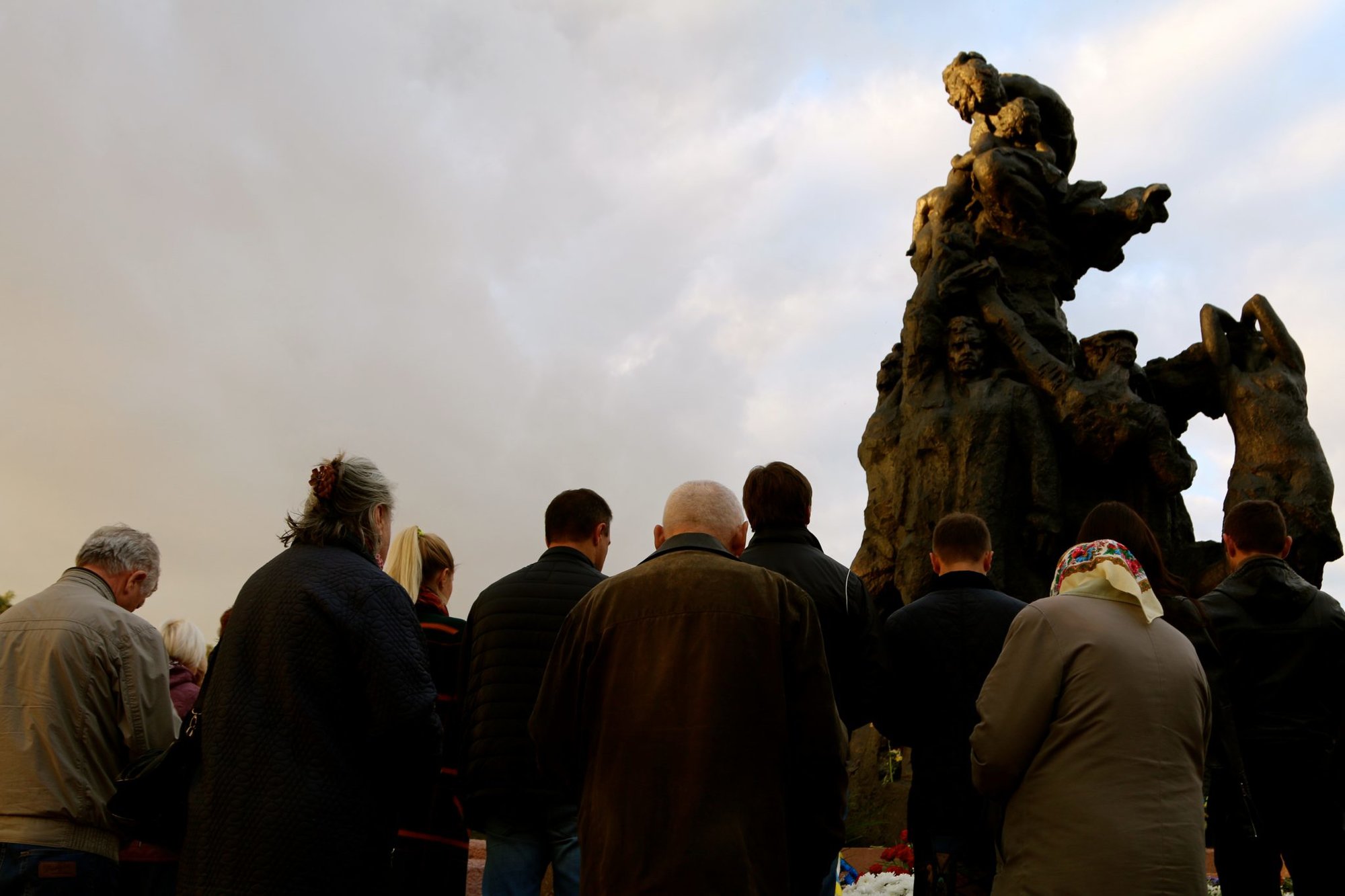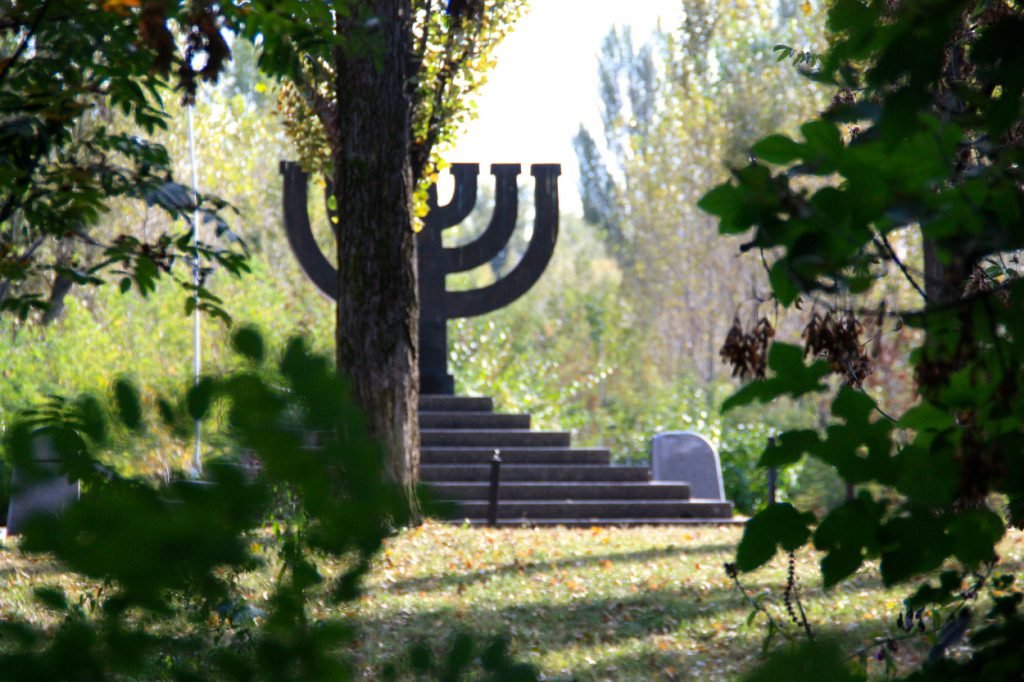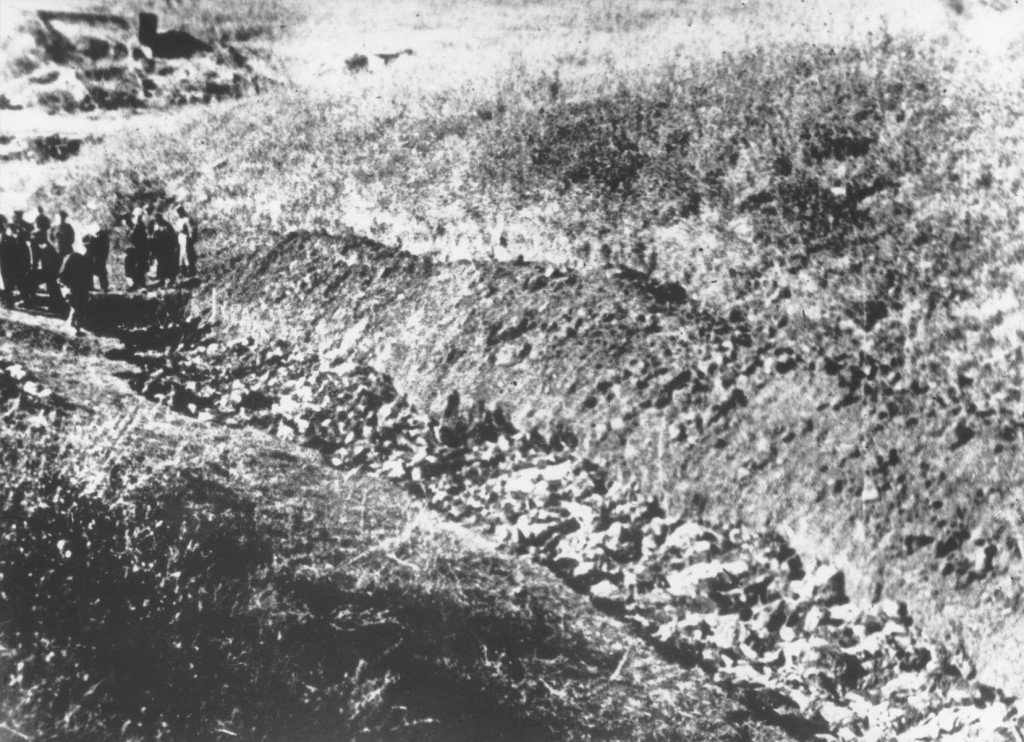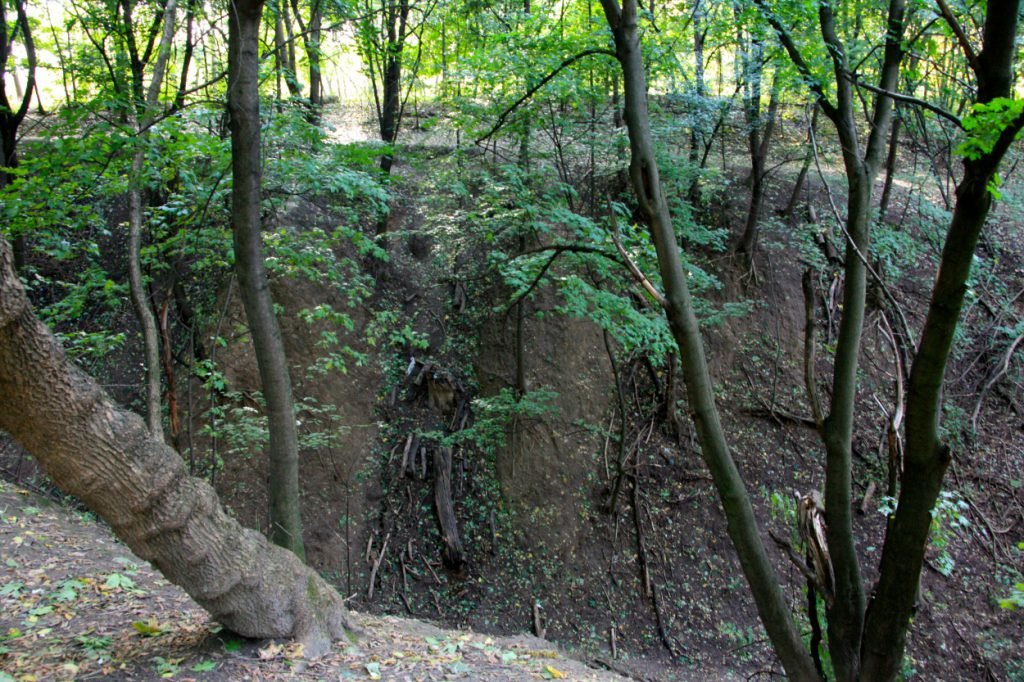In the Presence of Evil at Kyiv’s Babyn Yar Ravine, Site of a Nazi Holocaust Massacre

A memorial ceremony at Babyn Yar in Kyiv. Photo by Nolan Peterson/Coffee or Die.
KYIV, Ukraine — I walk alone on a gray winter day. The bare branches bend in the cold wind. Beside the path through Kyiv’s Babyn Yar memorial park, melted snow has turned the earth to black mud. I pass an old woman sitting on a bench. She has two bags by her feet. A kerchief covers her grayed hair. I look into her eyes but she does not look back.
What she must have seen in her life, this old woman? A famine in the 1930s, directed by Soviet Premier Josef Stalin, which killed millions of Ukrainians. Then, from 1939 to 1945, Ukraine was the deadliest battlefield of the deadliest war in human history. Decades of Soviet rule ensued, ending in the anarchic chaos of the 1990s. Only in 2014, the year Ukrainians took to the streets and overthrew the corrupt regime of Viktor Yanukovych, did the country finally free itself from Russian overlordship.
Yet, freedom is never free, and the price of freedom is often set by those who wish to destroy it. Today, after nearly seven years of constant combat, Ukrainian troops remain at war in their country’s eastern Donbas region, weathering daily Russian artillery and sniper fire.
Knowing all this, I hope to catch the old woman’s eyes. I hope to flash her a smile and convey my solidarity, my respect, my reverence for what she has endured.
But she never looks my way, and I continue on.
Past the old woman I follow a path made of concrete slabs. I pass an old man wearing a tweed blazer and fur ushanka hat who lumbers ahead, bent forward at the waist, arms folded behind his back. A young woman jogs past wearing a Lululemon workout ensemble and with Apple AirPods in her ears.
I reach the edge of the tree line where the ravine begins. The woods have grown so thick since the war that it’s hard to truly take stock of the gully’s depths these days. In winter, it’s a little easier. There are no leaves to look past.

I’ve been here before. In summer and in fall. But no matter the season, each trip to Babyn Yar — or Babi Yar — inevitably casts a shadow over me for days. Perhaps, I simply have an overactive imagination. After all, there’s nothing special about this place to suggest the horrors that happened here nearly 80 years ago. It is, according to all outward appearances, simply a tree line at the edge of a ravine.
But the suffering that the ground conceals here is radioactive. It hums and crackles, passing invisibly through the air, then right through me, damaging me from within. You can’t see it, touch it, or smell it. But you feel it. Call it ghosts, spirits, something ethereal and fantastic, or maybe just the mind trying to reconcile the ordinary collage of senses with the intellectually putrid knowledge of what happened here. In any case, there’s a particular way the hushed voices of the dead echo to the living in a place like Babyn Yar — a place where the Nazis murdered 100,000 people, mostly Jews, during World War II.
I find myself wondering: How could such a peaceful place have been the epicenter of something so evil?
The chain of events that led to the Holocaust seem all the more extraordinary when you see evidence of such remarkable evil in such a normal place. There was nothing about this particular plot of earth that could have possibly inspired Nazi soldiers to gun down tens of thousands of innocents. Whatever quantity of hate is required to commit such a crime, the Nazis brought it with them. The vile seed planted far away, only coming to fruition at this random spot.

Standing there at the edge of the chasm, I imagine how it all started on Sept. 26, 1941, when occupying Nazi soldiers posted this order in the heart of Kyiv:
“All Yids of the city of Kyiv and its vicinity must appear on Monday, Sept. 29, by 8 o’clock in the morning at the corner of Mel’nikova and Doktorivska streets (near the cemetery). Bring documents, money and valuables, and also warm clothing, linen, etc. Any Yids who do not follow this order and are found elsewhere will be shot. Any civilians who enter the dwellings left by Yids and appropriate the things in them will be shot.”
Three days later, nearly 34,000 Jews packed as much as they could carry and left their homes in Kyiv forever. Some arrived early, hoping for a better seat on the fictional resettlement trains. They all brought suitcases full of clothes, jewelry, art, and memories. Some children carried a stuffed animal in one hand and held a parent’s hand in the other as they spilled into Kyiv’s cobblestone streets for the 2-mile walk from the city center to the Babyn Yar ravine. Observing the crowds, people in nearby apartments described an “endless row” that was “overflowing the entire street and the sidewalks.”
The awaiting SS troops were surprised; they had only expected about 5,000 or 6,000 Jews to show up. The troops, part of the combat arm of the Nazis’ most fanatical organization, wondered if they had enough bullets for what they had been ordered to do.
As the procession marched along the road to Babyn Yar, most still believed the lie that they were to be resettled. But some within the crowd must have suspected that they were marching to their doom.
Maybe it happened when the SS troops started taking away their luggage, and then their coats, and then their clothes, and then their shoes and their underwear. Maybe they understood when they first heard the machine guns firing, or when they reached the end of the road and were beaten and driven in groups of 10 to the edge of the ravine and looked down at the pile of naked dead and waited for their turn as the bullets went down the line and the bodies dropped sharp and hard in the faster-than-gravity way that death pulls one to the earth.
Maybe during all of this, some finally understood what was happening to them. But a morning walk is hardly enough time to abandon all hope in the goodness of men and believe in the evil at your back.

By the night of Sept. 30, 1941, the bodies of 33,771 murdered Jews lay at the bottom of the Babyn Yar ravine. Over the next two years about 70,000 more bodies slid down the steep dirt slopes to join them — including ethnic minorities, communists, prisoners of war, Roma Gypsies, Ukrainian nationalists, and more Jews. The bodies remained there, naked in the earth, until August 1943, when the Nazis decided to conceal their crimes as the Soviet army advanced on Kyiv.
Paul Blobel, the Nazi commander of Sonderkommando 4a, whose troops had slaughtered the Jews of Kyiv, ordered his men and workers from the nearby Syrets concentration camp to dig up the bodies and burn them.
With the aid of bulldozers and bone-crushing machinery, the bodies were piled with wooden logs into pyres two stories high, doused with gas, and ignited. Each pyre contained about 1,500 bodies and burned for days. It took 40 days to burn all the bodies. With the evidence of their crime destroyed, the Nazis tried to kill the memory of it, too, by executing the concentration camp workers. But 25 of them escaped, and 15 survived the war to tell their stories.
In all, the Nazis murdered some 1.5 million Jews across Ukraine and Eastern Europe during the so-called “Holocaust by Bullets,” a period of improvisational genocide that presaged the mass killings at death camps such as Auschwitz and Treblinka. The Holocaust ultimately took the lives of about 6 million Jews, according to the United States Holocaust Memorial Museum.
Nevertheless, Stalin’s revision of history after World War II distorted the memory of what had happened at Babyn Yar, as well as the memory of the 850,000 to 900,000 Ukrainian Jews who died during the Holocaust.
Today, the ravine where the Nazis murdered about 100,000 is easy to miss. A few metal crosses hidden within the trees mark its edge, and a lonely statue of a menorah stands in a nearby clearing. Ukraine has plans to build a museum on the site; the project is tentatively scheduled for completion in 2025 or 2026. In November, Ukrainian officials announced that a synagogue will be built on the Babyn Yar site — the first new synagogue in Kyiv since Ukraine’s independence from the Soviet Union in 1991.

I stand at the lip of the ravine. Compelled by something — I don’t know what, exactly — I descend to the bottom. Where tens of thousands of bodies had fallen all those years ago, on this day the ravine’s muddy walls are steep and slick and carved by erosion. Trees angle from the earth, their roots holding the mud slope together. On the bottom, I reach up and break off a small piece of an overhanging branch bent in the strange, contorted ways it had blindly grown down here to look for light.
You see, after the war was over, the seeds returned to Babyn Yar. The seeds settled and sprouted roots in the mix of earth and human ash. Over time, the seeds grew into trees that left more seeds. A forest was born. At some point, one particular seed found its way to the bottom of the ravine. This seed took root and sprouted into a tree. Its trunk grew tall and its branches spread wide to search for the sun’s life-giving light. One of those hopeful branches grew in such a way that its tip was within my grasp. Just low enough for me to break off a small sign of life from this forgotten place of death.
I pocket the twig and climb out of the ravine. I walk through the park to the nearby metro station and half an hour later I’m ascending the stairs to my apartment, where my wife is waiting.
How quickly and easily we can escape the past. Yet that dividing line between so-called civilization and barbarism is thinner than we might want to admit. We are so easily lulled into the mistaken belief that history automatically arcs in the right direction. That the era of world wars and genocides is over. That it could never happen again.
But it could.
Remember — just two living generations ago, Ukraine was the deadliest battlefield of the deadliest war in human history. Some of the soldiers who fought in that war, and the civilians who survived its horrors, are still alive today. Thus, no one should think that another war like that is impossible, or that our generations are somehow immune to history’s perennial cycles of war and peace.
The truth is we are just treading water, fighting against the gravitational tug of history. The minute we stop kicking, we descend, quickly and easily, into those dark depths from which we thought we had escaped. So we can never relent. We must always remember that evil exists, in order to defend against it. And to prevent another Holocaust from happening, we must believe that it could.

BRCC and Bad Moon Print Press team up for an exclusive, limited-edition T-shirt design!
BRCC partners with Team Room Design for an exclusive T-shirt release!
Thirty Seconds Out has partnered with BRCC for an exclusive shirt design invoking the God of Winter.
Lucas O'Hara of Grizzly Forge has teamed up with BRCC for a badass, exclusive Shirt Club T-shirt design featuring his most popular knife and tiomahawk.
Coffee or Die sits down with one of the graphic designers behind Black Rifle Coffee's signature look and vibe.
Biden will award the Medal of Honor to a Vietnam War Army helicopter pilot who risked his life to save a reconnaissance team from almost certain death.
Ever wonder how much Jack Mandaville would f*ck sh*t up if he went back in time? The American Revolution didn't even see him coming.
A nearly 200-year-old West Point time capsule that at first appeared to yield little more than dust contains hidden treasure, the US Military Academy said.












